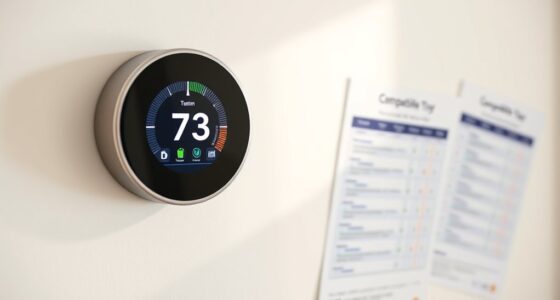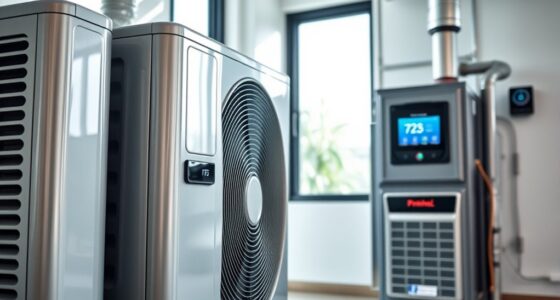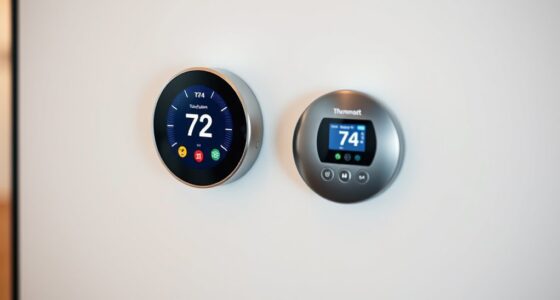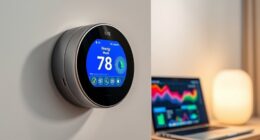Smart thermostat learning algorithms use AI to analyze your habits, preferences, and environmental data, allowing the system to adapt your climate control automatically. By collecting ongoing data like occupancy, weather forecasts, and user feedback, the thermostat predicts your comfort needs and adjusts settings proactively. This continuous learning optimizes energy use, reduces bills, and enhances your comfort seamlessly. To understand how this sophisticated process works, explore the details further.
Key Takeaways
- Utilize machine learning to analyze environmental and user data, predicting optimal temperature settings for personalized comfort.
- Continuously adapt schedules by learning from user habits, preferences, and occupancy patterns over time.
- Integrate external data like weather forecasts to proactively adjust climate control for efficiency and comfort.
- Employ sensors and user feedback to calibrate models, ensuring precise and responsive climate management.
- Prioritize data security and privacy while collecting detailed routine information to enhance AI-driven personalization.
How Learning Algorithms Power Smart Thermostats
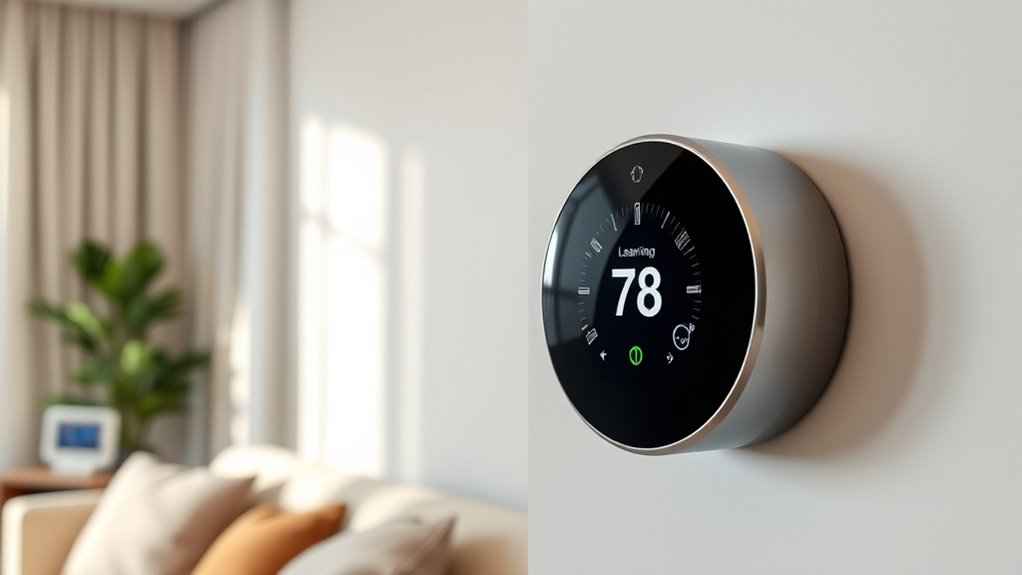
Learning algorithms are the core technology that makes smart thermostats intelligent. They analyze your habits, preferences, and environmental data to optimize comfort and energy savings. When you use voice control, these algorithms interpret your commands accurately, adjusting settings seamlessly. The user interface is designed to be intuitive, allowing you to interact effortlessly with your device. As you modify temperature or schedules, the algorithms learn from your responses, refining their predictions over time. This continuous adaptation guarantees your home remains comfortable without manual adjustments. By integrating voice control and a user-friendly interface, learning algorithms transform your thermostat into a responsive, efficient system that anticipates your needs and simplifies your daily routine. Additionally, high accuracy in data interpretation ensures the system’s recommendations are reliable and tailored to your unique environment. Incorporating security features is also crucial to protect your data and maintain trust in these intelligent systems.
Key Technologies Behind Adaptive Climate Control
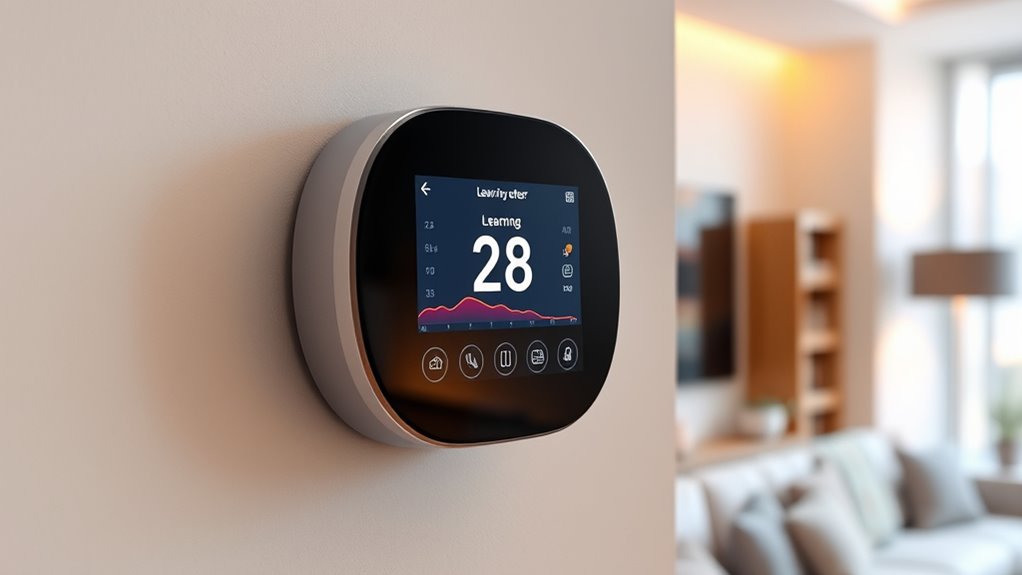
At the heart of adaptive climate control are advanced sensors and data processing technologies that continuously monitor your home’s environment. These sensors gather real-time data on temperature, humidity, and occupancy, feeding it into intelligent algorithms. A user interface allows you to easily control and customize your thermostat settings, making adjustments simple and intuitive. Voice recognition is a key technology here, enabling you to give commands hands-free and interact naturally with your system. This seamless integration makes it easier to fine-tune your comfort preferences without fuss. Together, these technologies create a responsive, personalized climate control experience, adapting to your lifestyle and preferences. They form the backbone of smart thermostats, delivering comfort with efficiency and ease.
Gathering Data: The Foundation of Personalization

Have you ever wondered how your smart thermostat knows exactly when to adjust the temperature? It starts with gathering data through carefully calibrated sensors that detect room temperature, humidity, and occupancy. Proper sensor calibration guarantees accurate readings, which are vital for reliable adjustments. Your user interface plays a pivotal role here, allowing you to input preferences and receive feedback on system performance. As you interact with the thermostat, it continuously collects data to build a profile of your habits and comfort levels. This foundational data fuels the learning algorithms, enabling personalized climate control. Additionally, understanding privacy boundaries factors, such as your daily routines and activity patterns, further enhances the system’s ability to adapt effectively. By accurately capturing environmental conditions and your inputs, the thermostat creates a tailored experience that adapts seamlessly to your lifestyle.
Analyzing Habits for Optimal Comfort
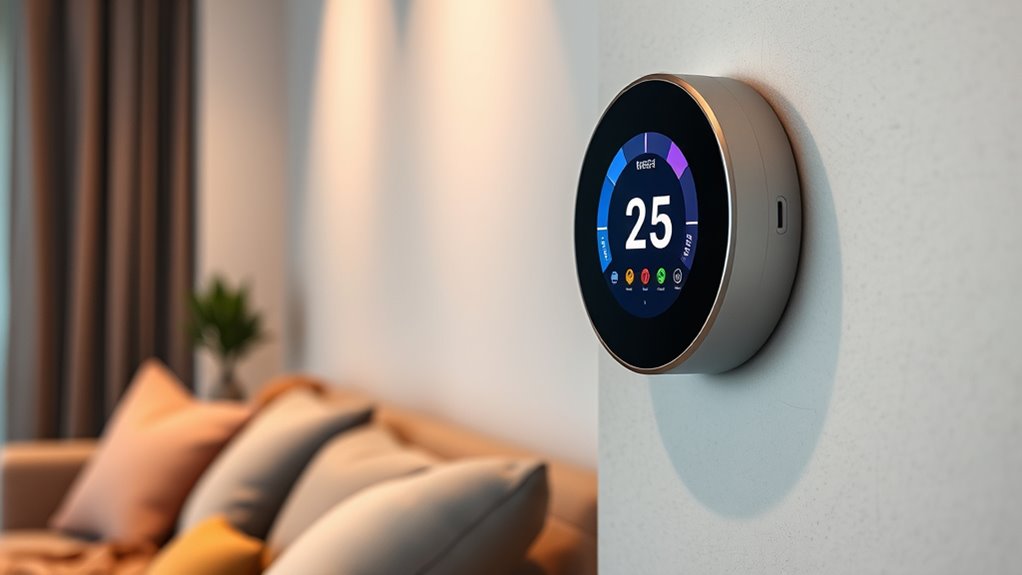
Once your thermostat has gathered enough data about your environment and interactions, it begins analyzing your habits to optimize comfort. It studies patterns like your preferred temperatures at different times and how long you stay in each space. By understanding occupant psychology, it predicts when you’ll want warmth or coolness, adjusting proactively. The system also considers aesthetic design, ensuring controls and displays are intuitive and blend seamlessly with your decor, making adjustments feel natural. This analysis enables your thermostat to learn, refine, and personalize settings, creating a comfortable environment tailored to your routines. Additionally, incorporating behavioral patterns principles can enhance your understanding of behavioral patterns, leading to more effective and satisfying adjustments. Recognizing store hours can help you plan your shopping trips more efficiently, ensuring you visit when your preferred stores are open. Over time, it anticipates your needs, reducing manual adjustments and enhancing your overall experience. This intelligent habit analysis makes your home smarter, more responsive, and perfectly aligned with your lifestyle.
Weather Integration and External Data Use
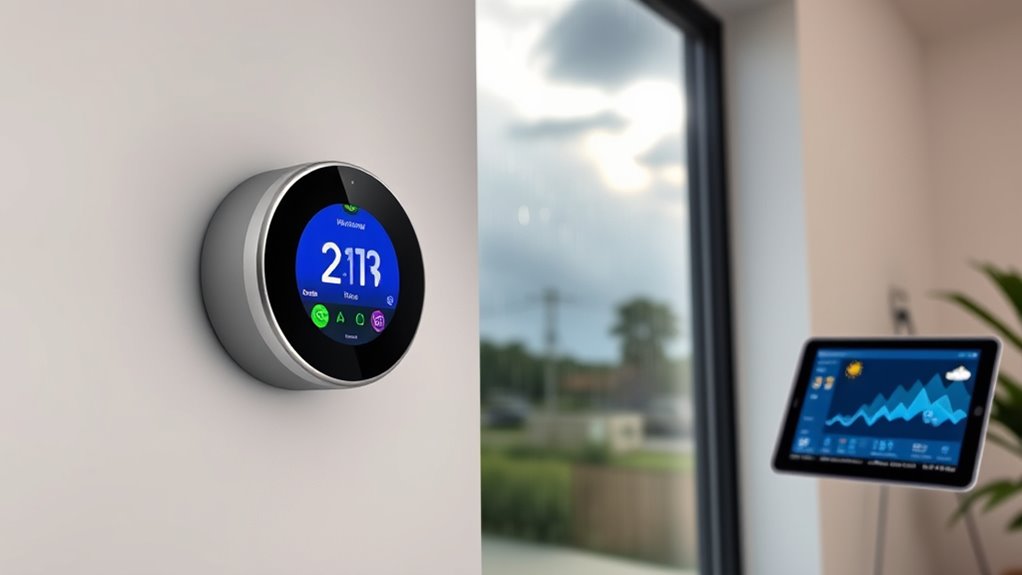
Weather patterns directly influence how your thermostat adjusts settings, so integrating local forecasts helps improve comfort and efficiency. External data synchronization allows your system to adapt quickly to changing conditions, ensuring peak performance. By analyzing weather data, your thermostat can make smarter decisions without requiring manual input. Incorporating AI-driven safety measures can further enhance reliability and user trust in your smart system. Additionally, leveraging real-time weather updates ensures your thermostat remains responsive to sudden climate changes, maximizing energy savings and comfort. Implementing adaptive learning algorithms enables the thermostat to better understand your preferences over time, optimizing performance further.
Weather Pattern Analysis
How can smart thermostats optimize heating and cooling schedules? By analyzing weather patterns, they anticipate changes, adjusting your home’s temperature proactively. This weather pattern analysis enables the system to incorporate external data, such as forecasts and historical climate trends, improving accuracy. It also supports predictive maintenance by identifying irregularities that could indicate equipment issues. Engaging you through personalized, adaptive settings, the thermostat learns your preferences based on weather fluctuations, enhancing user engagement. As a result, your system runs more efficiently, reducing energy use and costs. Continuous weather analysis helps prevent overcooling or overheating during unexpected shifts, maintaining comfort with minimal effort from you. Monitoring temperature variations allows the system to respond even more precisely to environmental changes, further optimizing comfort and efficiency. Additionally, integrating real-time weather updates enables the thermostat to adapt swiftly to sudden weather events, ensuring consistent comfort. This intelligent integration ensures your home stays comfortable while optimizing performance and extending your system’s lifespan.
External Data Synchronization
External data synchronization allows your smart thermostat to seamlessly incorporate real-time weather information and forecasts, ensuring your home’s heating and cooling are always optimized. By integrating external data, the thermostat can adjust settings based on upcoming weather changes, improving energy efficiency and comfort. This process also considers solar efficiency, optimizing your system to maximize natural sunlight and reduce energy use. The user interface becomes more intuitive as it displays relevant weather data and personalized suggestions, making adjustments easier. External data syncs with your thermostat’s learning algorithms, enhancing overall performance and ensuring your home remains comfortable regardless of outside conditions. Incorporating advanced data integration techniques can further refine these adjustments by leveraging additional environmental factors. This integration helps prevent unnecessary energy waste and supports smarter, more responsive climate control. Additionally, leveraging automation in business principles allows the thermostat to adapt dynamically to changing conditions, further optimizing energy consumption and comfort. Moreover, syncing external data with your system can contribute to sustainable living by promoting responsible energy use.
Machine Learning Models and Continuous Improvement
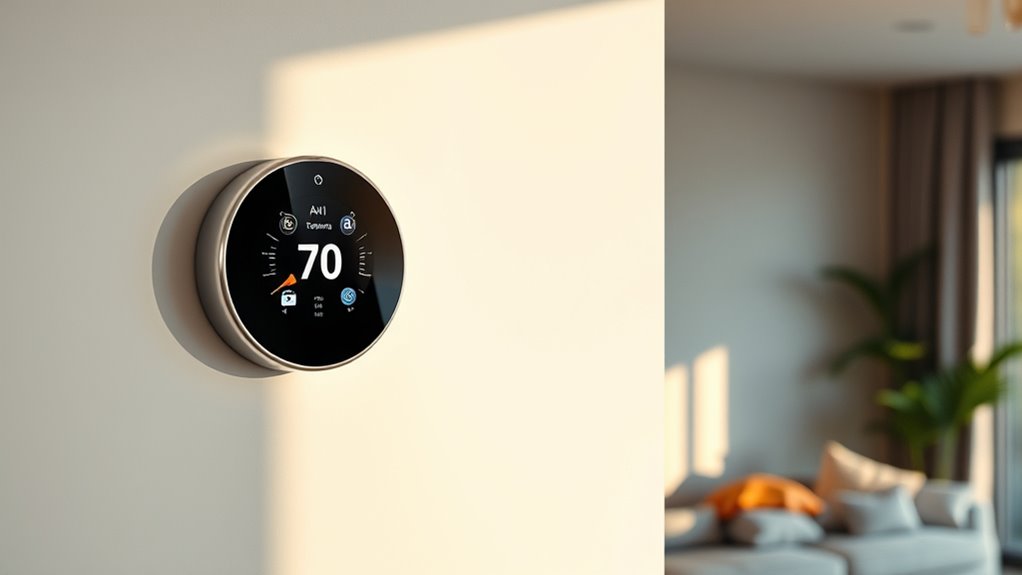
Machine learning models in smart thermostats continuously adapt to your heating and cooling patterns by analyzing data over time. As your habits evolve, these models refine their predictions, optimizing comfort and efficiency. However, privacy concerns arise because these systems collect sensitive data about your daily routines. To address this, manufacturers incorporate robust security measures and transparent data policies. Additionally, user interface design plays a crucial role in how easily you can review and manage your data preferences. A clear, intuitive interface helps you feel confident about your privacy while enabling seamless adjustments. Continuous improvement relies on this balance—learning from your behavior without compromising your privacy. Advances in AI technology contribute to more sophisticated and personalized systems, ensuring comfort while respecting your data security. As a result, your thermostat becomes smarter and more personalized, ensuring comfort while respecting your data security. Incorporating user control options allows users to customize how their data is collected and used, fostering trust and transparency. Moreover, implementing cybersecurity measures is essential to protect these systems from potential vulnerabilities and malicious attacks.
Benefits of AI-Driven Temperature Management
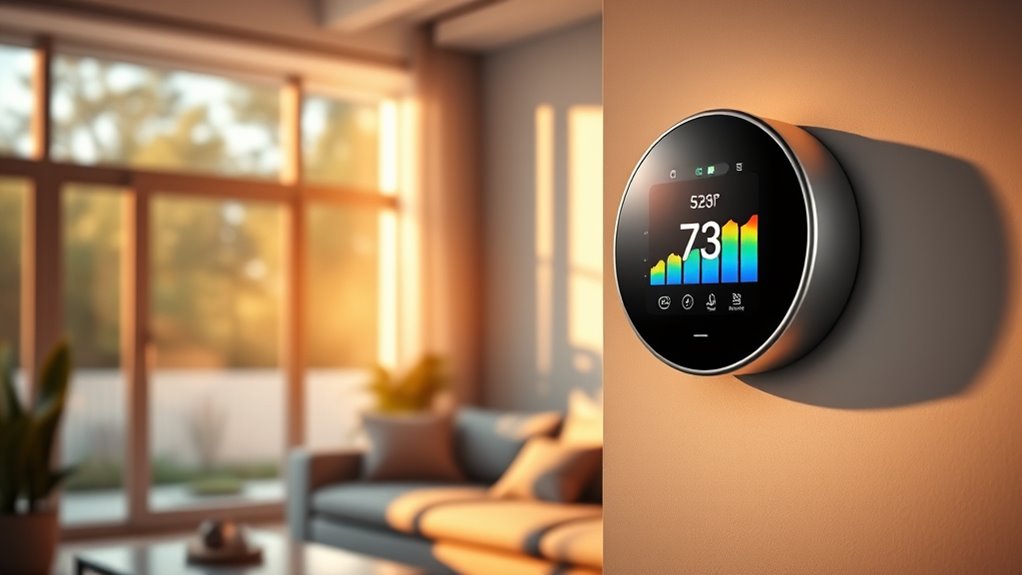
AI-driven temperature management helps you save energy by optimizing your heating and cooling systems. It also personalizes comfort settings to match your daily routines, ensuring you stay comfortable. With adaptive learning capabilities, your thermostat continuously adjusts to your preferences, making your home smarter and more efficient. Incorporating sound design techniques can further enhance the user experience by providing intuitive feedback and seamless operation. Additionally, integrating expert voice actors in notifications and alerts can create a more engaging and trustworthy interface. For example, Hyundai Tuning principles can inspire more responsive and finely tuned smart system adjustments to improve overall comfort.
Energy Efficiency Gains
By intelligently learning your heating and cooling patterns, smart thermostats considerably reduce energy consumption. They optimize your system’s operation, ensuring your home uses only what’s needed, minimizing waste. This efficiency not only lowers your utility bills but also supports the use of renewable sources by aligning energy use with cleaner energy generation times. Additionally, AI-driven management improves grid integration by adjusting your heating and cooling based on real-time energy demand and supply. During peak periods, your thermostat can reduce unnecessary energy use, easing strain on the grid. This coordinated approach helps foster a more sustainable energy ecosystem, benefiting everyone. Moreover, hydrogen fuel cells are emerging as a clean energy solution that can be integrated into smart grid systems, further enhancing sustainability. Incorporating renewable energy sources into your energy management system can maximize the environmental benefits of smart technology. Utilizing smart algorithms allows for dynamic adjustments that respond to fluctuating energy conditions, optimizing overall efficiency and environmental impact. Overall, these smart algorithms help you save money while promoting environmentally friendly energy practices.
Personalized Comfort Settings
Since smart thermostats learn your routines, they can automatically adjust temperatures to match your preferred comfort levels throughout the day. This personalized approach guarantees your home feels just right without manual input. Voice control makes it easy to change settings on the spot, providing hands-free convenience. The user interface is intuitive, allowing you to fine-tune your comfort preferences effortlessly. Over time, the thermostat adapts to your schedule, reducing temperature fluctuations that disrupt your comfort. You’ll experience consistent warmth or coolness exactly when you want it, without fiddling with controls. This tailored temperature management not only enhances your comfort but also optimizes energy use, making your home smarter and more responsive to your lifestyle needs.
Adaptive Learning Capabilities
Adaptive learning capabilities enable your smart thermostat to continuously analyze your habits and preferences, making real-time adjustments that optimize comfort and energy efficiency. This feature enhances the user interface, allowing you to easily see how your habits influence temperature settings. As the thermostat learns, your engagement increases because it responds seamlessly to your routines, reducing the need for manual adjustments. You’ll notice it anticipates changes, such as adjusting the temperature before you arrive home or during sleep hours. This ongoing process not only improves comfort but also saves energy by avoiding unnecessary heating or cooling. Over time, the system becomes more intuitive, simplifying your interactions and creating a more personalized experience that aligns with your lifestyle.
Future Trends in Smart Thermostat Technology
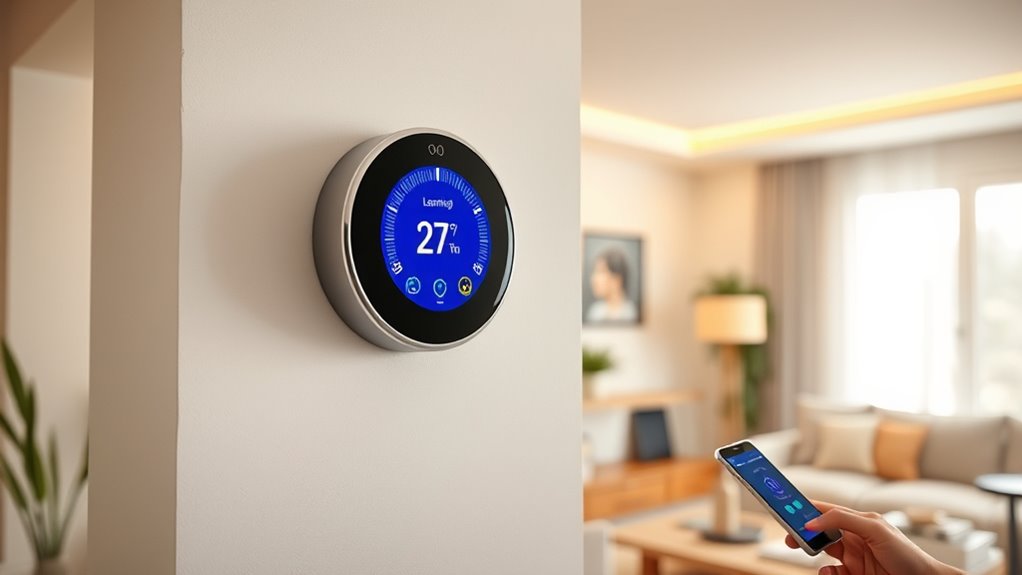
As smart thermostat technology continues to evolve, future trends are set to make home climate control more intuitive and energy-efficient. Voice control will become more seamless, allowing you to adjust settings effortlessly through natural conversations. Expect user interfaces to become smarter, offering personalized suggestions based on your habits and preferences. Advanced AI will predict your comfort needs before you even ask, optimizing temperature schedules automatically. Integration with other smart home devices will create a cohesive environment, reducing energy waste. Additionally, enhanced data security measures will protect your privacy as these systems gather more detailed insights. Overall, future smart thermostats will adapt more proactively, making home climate management easier, more responsive, and tailored specifically to your lifestyle.
Frequently Asked Questions
How Secure Is the Data Collected by Smart Thermostats?
You might wonder how secure your data is with smart thermostats. Generally, companies use data encryption to protect your information from unauthorized access, and they often prioritize user anonymity to keep your identity private. However, no device is completely risk-free. You should regularly update firmware, change default passwords, and review privacy settings to guarantee your data remains secure and your privacy is maintained.
Can Users Manually Override AI Adjustments Easily?
You can easily perform manual overrides to regain control over your thermostat settings whenever needed. Most smart thermostats offer straightforward options for users to adjust temperature manually, bypassing AI adjustments temporarily or permanently. This gives you the flexibility to override AI learning algorithms and set your preferred comfort level. User control is a key feature, ensuring you’re not solely dependent on automated adjustments and can tailor your environment instantly.
Do Learning Algorithms Adapt to Unusual or Inconsistent Schedules?
They say “variety is the spice of life,” and your thermostat’s adaptive learning algorithms recognize this. When you have schedule variability or inconsistent routines, these algorithms adapt by analyzing your habits over time. They learn from unusual patterns, ensuring your home stays comfortable without constant manual adjustments. While not perfect, they become smarter with each change, helping you maintain your ideal environment despite unpredictable schedules.
How Do Smart Thermostats Handle Multiple Users With Different Preferences?
When managing multiple users with different preferences, smart thermostats create individual user profiles to track each person’s temperature choices. They use these profiles to personalize settings, often blending preferences to resolve conflicts. If preferences clash, the thermostat may prioritize the most recent user or suggest compromise options. This way, you get a comfortable environment tailored to everyone’s needs, with the device intelligently balancing different preferences for ideal comfort.
Are There Privacy Concerns With External Data Integration?
You might wonder if integrating external data raises privacy concerns. When smart thermostats use third-party sharing, they often implement data anonymization to protect your identity. However, you should be aware that some data might still be shared or stored externally, which could be risky if not properly secured. Always check the privacy policies and opt for devices that prioritize data privacy to guarantee your information stays protected.
Conclusion
So, next time your smart thermostat seems to know you better than your best friend, remember it’s all thanks to clever algorithms working behind the scenes. You might think you’re the one controlling your comfort, but really, it’s AI quietly learning your habits—talk about a subtle invasion of privacy with a friendly face. Who knew that your cozy home was being perfectly tuned by machines that just can’t get enough of studying you?


